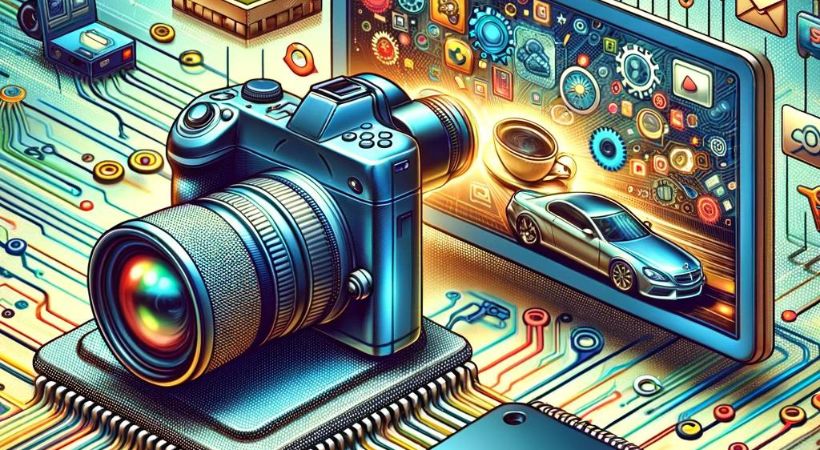Unveiling the Tools Behind Object Recognition: A Deep Dive into Deep Learning Equipment
In the rapidly evolving field of artificial intelligence (AI), object recognition stands as a cornerstone application for deep learning and machine learning, driving advancements in various industries from security to healthcare, and from retail to autonomous vehicles. At the heart of these groundbreaking technologies like pattern recognition and object class identification lies an array of sophisticated computer vision equipment, both hardware and software, working in tandem to interpret the visual world around us. This blog post explores the essential tools and technologies that power object recognition systems, shedding light on how they function and the type of object they interact with to achieve remarkable results.
Object Recognition Hardware Backbone
Cameras and Sensors
The first step in any object recognition system’s learning approach is capturing the visual data, which is where cameras and sensors come into play for accurate object localization in an image. High-resolution cameras, infrared sensors, depth sensors, and LiDAR (Light Detection and Ranging) systems are some of the key hardware components used to collect detailed images and spatial information of the environment. These devices vary in their capabilities, with some offering advanced features like night vision or the ability to capture 3D information, enabling the object recognition model to operate under a wide range of conditions.
Types of cameras and sensors used for computer vision tasks:
- Digital Cameras: High-resolution cameras for capturing detailed images.
- Infrared Cameras: For visual recognition challenges such as low light or through obscurants like fog.
- Thermal Cameras: Object localization is particularly useful for detecting objects based on heat signatures, especially in security and surveillance.
- 3D Cameras and LiDAR Sensors: Provide depth information, crucial for applications requiring spatial understanding of objects, which often involves understanding the difference between object recognition and image segmentation.
- Motion Sensors play an essential role in visual recognition of objects in images.: Can trigger image capture for object recognition in response to detected movement.
- Environmental Sensors: Such as light or temperature sensors, can provide contextual information that enhances object recognition accuracy under varying conditions.
Processing Units
Once the visual data is captured, it needs to be processed with deep learning techniques such as convolutional networks for visual recognition. This is where powerful CPUs (Central Processing Units) and GPUs (Graphics Processing Units) come into the picture. GPUs, in particular, have become increasingly important in the field of AI and object detection due to their ability to handle parallel recognition tasks, making them ideal for processing the complex algorithms involved in identifying and classifying objects in real-time. For edge computing applications, where data processing happens on or near the device itself, specialized hardware like FPGAs (Field-Programmable Gate Arrays) and ASICs (Application-Specific Integrated Circuits) are also used to achieve high efficiency and low power consumption.
Computational hardware for image recognition: Essential for any system that requires the accurate recognition of an object in an image.
- CPUs (Central Processing Units): General-purpose processors capable of handling a variety of tasks, including running algorithms for object recognition.
- GPUs (Graphics Processing Units): Specialized for parallel processing, GPUs significantly speed up the computation involved in object recognition, particularly in deep learning-based methods.
- FPGAs (Field-Programmable Gate Arrays): Can be programmed to perform specific computation tasks very efficiently, offering a balance between the flexibility of CPUs and the speed of GPUs.
- ASICs (Application-Specific Integrated Circuits): Custom-built for specific tasks, such as neural network processing, offering the highest efficiency for repetitive tasks like object recognition.
Object Recognition Software Framework
Machine Learning and Deep Learning Libraries
The brains behind object recognition lie in the sophisticated algorithms developed through machine learning and deep learning. Libraries such as TensorFlow, PyTorch, and OpenCV provide the tools for developers to train models on vast datasets of images or videos, teaching the system image classification to recognize and differentiate between objects. These libraries offer a wide range of functionalities, from basic image processing to the implementation of complex neural networks, and are constantly being updated with the latest advancements in AI research.
TensorFlow
Developed by the Google Brain team, TensorFlow is an open-source library for numerical computation and machine learning that makes the development of ML models more accessible and scalable. TensorFlow is particularly well-suited for deep learning tasks, including object recognition, due to its flexible architecture that allows for easy deployment of computation across a variety of platforms (CPUs, GPUs, TPUs).
- Key Features: TensorFlow supports both desktop and mobile platforms and provides a comprehensive ecosystem of tools, libraries, and community resources that help researchers develop and deploy ML models efficiently.
- Advantages: Its scalability and versatility make TensorFlow, a computer vision technique, ideal for large-scale applications in object recognition. TensorFlow’s integrated Keras API facilitates rapid and easy model design and experimentation.
- ApplicationsTensorFlow is widely used in facial recognition, autonomous vehicles, and image classification applications where its ability to process large datasets and perform complex computations, like recognition using deep learning, is crucial.
PyTorch
PyTorch, developed by Facebook’s AI Research lab, is an open-source machine learning library based on the Torch library for tasks including type of object recognition. It is known for its flexibility, ease of use, and dynamic computational graph that allows for adjustments to the graph on the fly. PyTorch, with its intuitive design and straightforward syntax, is particularly favored for academic research and prototyping object recognition systems using a convolutional neural network.
- Key Features: PyTorch provides strong support for GPU acceleration, enhancing its performance in training deep learning models. It also offers dynamic computation graphs, which are particularly beneficial for projects that require frequent changes to the model architecture, such as those involving dynamic object localization or object class identification.
- AdvantagesThe library is user-friendly, making it easier for beginners to get started with deep learning and use object recognition. PyTorch’s dynamic nature allows for more interactive and intuitive model development compared to static graph libraries.
- Applications: PyTorch is extensively used in projects that require fast iteration and flexibility, such as experimental projects, research in new object recognition algorithms, and applications where model architecture changes frequently.
OpenCV
OpenCV (Open Source Computer Vision Library) is a library of programming functions mainly aimed at real-time computer vision. Originally developed by Intel, it’s widely used for operations on images and videos, including object detection and recognition, a computer vision task often confused in object recognition vs image segmentation discussions. Unlike TensorFlow and PyTorch, which are more focused on deep learning, OpenCV provides a broad range of computer vision functionalities, including traditional algorithmic approaches and object recognition, a computer process often confused in the object recognition vs pattern recognition discussion.
- Key Features: OpenCV supports a wide variety of programming languages, including Python, Java, and C++, and can run on different platforms. It offers optimized algorithms for image and video analysis, including face recognition and object identification.
- Advantages: Its extensive collection of algorithms and its efficiency in processing make OpenCV a go-to library for computer vision tasks. It is particularly useful for applications that require real-time processing.
- Applications: OpenCV is used in a myriad of applications, from security systems and industrial inspection to augmented reality and interactive art installations. Its capabilities enable the development of complex object recognition systems using a convolutional neural network, that can operate in real-time environments.
Datasets and Annotation Tools
Training an object recognition system requires not just algorithms but also extensive datasets consisting of labeled images with accurate object definitions. Datasets like ImageNet, COCO (Common Objects in Context), and PASCAL VOC have been instrumental in the development of object recognition technologies. Alongside these datasets, annotation tools play a critical role in the training process, enabling the accurate labeling of objects in images to teach the AI models how to use object recognition.
Integration and Application
Bringing it all together, the integration of hardware and software forms the foundation of object recognition systems. Developers combine the computational power of CPUs and GPUs with the intelligence of machine learning algorithms to interpret the data captured by cameras and sensors. This integration is fine-tuned to meet the specific requirements of various applications, from facial recognition for security purposes to object detection in autonomous vehicles.
The field of object recognition continues to advance at a rapid pace, with new technologies and methodologies emerging regularly. As AI becomes increasingly integrated into our daily lives, understanding the equipment and technologies that make it possible is essential for anyone looking to grasp the potential and direction of this transformative field. Whether you’re a developer, a business leader, or simply an AI enthusiast, the tools of object recognition offer a fascinating glimpse into the future of technology.
Conclusion
In conclusion, object recognition with deep learning has made remarkable strides, transforming the way machines interpret and interact with the visual world. The intricate dance between sophisticated hardware and advanced software libraries is at the heart of this transformation, enabling systems to recognize and categorize objects with increasing accuracy and speed. High-resolution cameras and sensors capture the world around us, while powerful CPUs and GPUs process this information, turning raw data into actionable insights.
As we look to the future, the potential applications of an accurate object recognition model are boundless. From enhancing security systems with facial recognition to advancing autonomous vehicle technology, and from improving patient diagnostics in healthcare to creating more engaging retail experiences, the possibilities are limited only by our imagination. Moreover, as the technology continues to evolve, we can expect object recognition systems to become more integrated into our daily lives, making our interactions with technology more natural and intuitive.
The journey of object recognition technology, a computer vision technique, is a testament to the power of human ingenuity and collaboration. By leveraging the strengths of both hardware and software, we have taken significant steps toward creating machines that see and understand the world in ways that were once the realm of science fiction. As we continue to explore and innovate, the future of object recognition holds exciting prospects, promising to revolutionize industries and enhance human life in ways we are just beginning to envision.
Ready to Explore the Future of Object Recognition with Secured™?
In a world where technology continually reshapes our lives, object recognition stands out as a transformative force, offering endless possibilities for innovation and improvement across various sectors. Whether you’re looking to enhance security, pioneer autonomous solutions, or revolutionize diagnostics, object recognition using object detection models holds the key to unlocking new potentials.
At Secured™, we’re at the forefront of using machine learning, harnessing the power of advanced object recognition, a computer vision technique, to create tailor-made solutions that meet your unique needs and challenges. Our team of experts, equipped with deep industry knowledge and cutting-edge technology, is ready to guide you through the vast landscape of possibilities that our methods for object recognition offer.
Don’t miss the opportunity to stay ahead in the rapidly evolving digital world. Schedule a consultation with Secured™’s experts today to learn how object recognition can transform your operations, enhance your services, and drive your success. Together, we’ll explore innovative solutions that are not only effective but also secure and scalable, ensuring you’re well-equipped for the challenges and opportunities like object recognition vs image segmentation of tomorrow.
Take the first step towards unlocking the full potential of object recognition technology. Contact us now to discover how Secured™ can help you navigate the future with confidence and precision in terms like object recognition, convolutional networks for visual recognition or image segmentation. Let’s shape the future together — one visionary solution at a time.
Secure Your Future Today.

